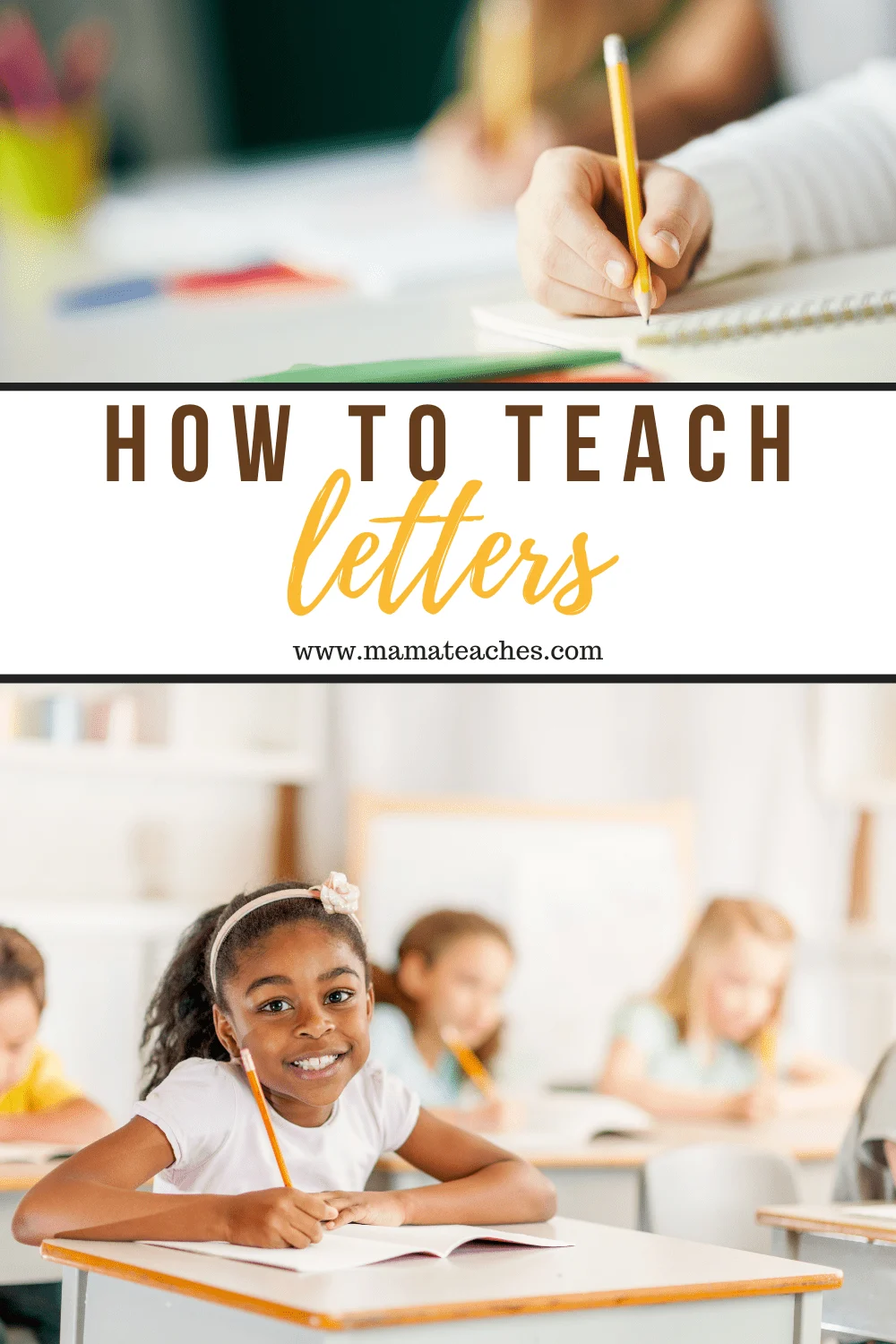You know the song: “A-B-C is easy as 1-2-3.” But teaching the ABCs?
Here’s the skinny on how to teach letters in a simple, fun, and memorable way.

This article contains affiliate links to things that you might like.
How to Teach the Alphabet
Hands-on Activities
If you are wondering how to teach your child to recognize the letters of the alphabet, make it tactile!
Little children love to explore the world through all their senses–they want to touch and feel everything.
So let them “feel” their way through the alphabet.
- Make It Puzzling. Who doesn’t love the thrill of finding the perfect fit? Alphabet puzzles are not only an activity, they also provide you with three-dimensional letters your child can touch and feel. Wooden puzzles are a classic. This multipack has upper and lowercase letters (more on that later) as well as numbers. As an alternative, try foam puzzles. The advantage? Foam puzzles can get wet!
- Make It Sandy. The Montessori method of how to teach the alphabet emphasizes hands-on, experiential learning. They promote using sandpaper letters. Your child can see the letters in their natural environment, printed on a page, but can also feel them–a plus for kinesthetic learners.
- Make It Fridge-Worthy. If you love having a pristine, clutter-free fridge (we all can dream, right?) consider making room for fridge magnets for this season. This interactive set of Leapfrog Fridge Magnets not only has three-dimensional letters but when you place a letter in the barn, Leap will sing a song. Even toddlers love this toy.

When It Is Developmentally Appropriate
So that you have the letters, when do you start using them?
This is an important question when considering how to teach letters.
You never want to frustrate a child by asking her to learn something her brain is not yet ready to learn.
Here is where to start:
- Sing the ABCs. You really can’t begin this too young. Sing this song to your little one every time you change a diaper. Sing this while training them to wash their hands for 20 seconds. Sing it at a stoplight. I guarantee that if you sing this song everyday, your child will learn it fast! Knowing the alphabet song is a memory peg on which your child can hang later learning: connecting letter shapes to letter names and sounds.
- Wait for the Words. Your child doesn’t need to have a 40,000 word vocabulary before you begin to teach letter names, but he should be able to say most words. If you hold up a cookie and your child can say “cookie,” then he is certainly ready for you to hold up the letter A and say “A.”
- Keep it 3-D. Little children are concrete learners. They are busy exploring what they can see, hear, feel, taste, and touch. If you can tie learning to a combination of those senses, that makes it even easier (and more fun) for them. Print on a page is flat and often black on white. It is strictly visual. When you use three-dimensional letters (like foam or wooden letters), those letters are visual and tactile.
- Wait to Write. Many letter recognition programs jump straight into a workbook approach. They tie reading and writing (and sometimes even spelling) together. Hold up! A child is developmentally ready to recognize letters way before he can physically write them. By all means work on fine motor skills, but don’t hamper your child’s beginning reading progress by expecting him to write as well.
- Upper or Lower? Do you start teaching the uppercase or lowercase letters first? Proponents of uppercase first argue that these letters are more visually distinct from one another and thus easier to learn. I taught my kids their lowercase letters first because there are far more of them in print. This made it more likely that we could point them in real life: on cereal boxes, street signs, and in books. Either way is fine. Just pick one and stick with it.

Fun Ways to Practice letters
If you want to know the secret of how to teach letters to preschoolers (and even younger), the secret is…keep it simple, playful, and informal.
You just need to take what you are already doing and give it an educational twist.
You already read to your child. Pick some books that have letters in bright, bold font and add that to the bedtime stack. Classics such as Dr. Seuss’s ABC, Chicka Chicka Boom Boom, and Eat the Alphabet are great examples. Each of these books also comes in a shortened board book version for the littlest learner.
You already look for ways to keep your child entertained (that don’t involve screens). Make sensory bag seek and find by throwing a few letters in a gallon-sized bag of dried rice or beans or water beads (do this only if you bought the waterproof foam letters). You can also have your child finger trace a letter (if they are ready for this) on a rimmed cookie sheet. You can use shaving cream, grits or sand, or even flour mixed with spices (pumpkin pie spiced letters? Yes please!).
You already feed your child. Why not have an alphabet-themed lunch? Pick a letter of the day and have a lunch or snack based on that letter. You can use alphabet cookie cutters to really make it fun. How about an A-shaped sandwich, some almonds, and a sliced apple? Nutritious and educational!
You already bathe your child. Put some bath foam letters in the tub. Play silly games like “hungry washcloth.” (“The washcloth is hungry for the letter B. Can you feed him the letter B? Num, num, num!”)

Teaching Letters Should Be Fun
Your child will learn their ABCs eventually.
It’s a given.
But you can build his confidence by informally teaching him at home with these simple and fun activities.


